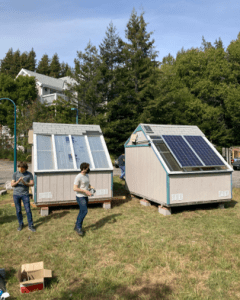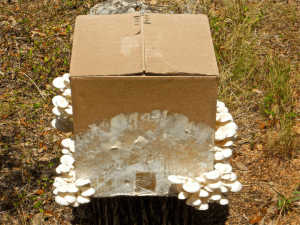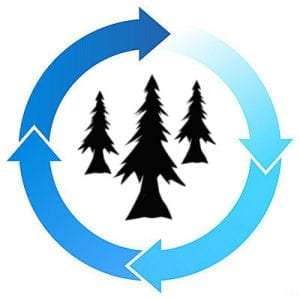Mycelial Solutions: Toadstool Composting
Food & Water Security
The Goal
Mycelial Solutions (MYSO) continues as an undergraduate-led team researching how mycoremediation can be leveraged to create sustainable solutions that relieve these inept recycling strategies for different waste streams. By observing how fungi (1) sequester environmental pollutants via biological uptake and (2) degrade polymers through enzyme production, the team has expanded beyond cardboard to research low energy and nontoxic mycoremediation for waste building materials and plastics. We are committed to finding sustainable cradle-to-cradle solutions to waste diversion and upcycling.
Updates
In spite of COVID shutdowns, Mycelial Solutions has been busy:
- They designed, installed and continue to maintain an automated solar power system for the mushrooms greenhouse sheds
- verified that oyster mushrooms are the most efficient fungus-based intermediary for bioremediation of contaminated cardboard products
- have joined forces with Greg Gilbert lab to identify a potential fungal strain to divert polyurethane from entering the waste stream
- explored a potential collaboration with CALFIRE and the Santa Cruz Water Department to understand the potential for mycoremediation of soil and watershed contamination due to residential fires
- won funding through IDEA Hub's pitch competition
- the City of Santa Cruz has made them the subject of a documentary to be submitted to the Environmental Justice Video Challenge for Students.
The development team is investigating how fungi can be leveraged as catalysts in bioremediation and regenerative design.
Background and Past Results
 Did you know that 50-70% recyclables delivered to our municipal Resource Recovery Facility at the Santa Cruz Dimeo Lane were actually solid waste contaminants, and therefore could not be recycled? This includes an estimated 56,000 lbs of waste from pizza boxes from the UCSC campus. Students alongside faculty mentors recognize the potential implications of this problem and came together in 2018 to form this S-Lab team, in collaboration with IDEASS and the Sustainability Studies Minor. Their aim is to use mushroom spawn to turn food-soiled cardboard and paper waste into compost and ultimately make a positive impact in the face of crippled infrastructure undermining the U.S. recycling industry. Tolerance of contamination in recycling has diminished radically ever since China put a customs crackdown on U.S. imports. Soiled cardboard - like pizza boxes - are considered contaminants when mixed in with the clean cardboard stockpiles. The good news is that cardboard retains moisture, corrugation allows for air exchange, and as a wood-based product, cardboard is a familiar substrate that mycelium can colonize while the resulting compost will rejuvenate soil, increase water holding capacity, and use the land as an effective carbon sink. The integration of oyster fungi strains with contaminated paper-based products can promote an accelerated decomposition rate of cardboard, napkins, and other paper products, in a compost system. One objective of lab experimentation is to determine if the residual biomass remaining after fungal decomposition is effective for composting. Experimentation in the lab will determine whether the introduction of additional nitrogen sources is needed to optimize the carbon-to-nitrogen ratios to increase mycelial growth and the viability of the resulting cardboard-compost slurry. Successful lab results will inform the establishment of colonies of mycelium and growing conditions in a shed which has been allocated for compost in collaboration with garden student communities on campus. Toadstool Composting is also considering other ways that fungi can assist in bioremediation such as the degradation of PHB (poly-3-hydroxybutyric acid), a thermoplastic polyester given that studies have shown that soil-containing environments were the habitats from which the largest number of fungal PHB degraders were found.
Did you know that 50-70% recyclables delivered to our municipal Resource Recovery Facility at the Santa Cruz Dimeo Lane were actually solid waste contaminants, and therefore could not be recycled? This includes an estimated 56,000 lbs of waste from pizza boxes from the UCSC campus. Students alongside faculty mentors recognize the potential implications of this problem and came together in 2018 to form this S-Lab team, in collaboration with IDEASS and the Sustainability Studies Minor. Their aim is to use mushroom spawn to turn food-soiled cardboard and paper waste into compost and ultimately make a positive impact in the face of crippled infrastructure undermining the U.S. recycling industry. Tolerance of contamination in recycling has diminished radically ever since China put a customs crackdown on U.S. imports. Soiled cardboard - like pizza boxes - are considered contaminants when mixed in with the clean cardboard stockpiles. The good news is that cardboard retains moisture, corrugation allows for air exchange, and as a wood-based product, cardboard is a familiar substrate that mycelium can colonize while the resulting compost will rejuvenate soil, increase water holding capacity, and use the land as an effective carbon sink. The integration of oyster fungi strains with contaminated paper-based products can promote an accelerated decomposition rate of cardboard, napkins, and other paper products, in a compost system. One objective of lab experimentation is to determine if the residual biomass remaining after fungal decomposition is effective for composting. Experimentation in the lab will determine whether the introduction of additional nitrogen sources is needed to optimize the carbon-to-nitrogen ratios to increase mycelial growth and the viability of the resulting cardboard-compost slurry. Successful lab results will inform the establishment of colonies of mycelium and growing conditions in a shed which has been allocated for compost in collaboration with garden student communities on campus. Toadstool Composting is also considering other ways that fungi can assist in bioremediation such as the degradation of PHB (poly-3-hydroxybutyric acid), a thermoplastic polyester given that studies have shown that soil-containing environments were the habitats from which the largest number of fungal PHB degraders were found.


The MySO Team would like to thank UCSC's Carbon Fund, IDEA Hub, and Greg Gilbert Lab for support.

